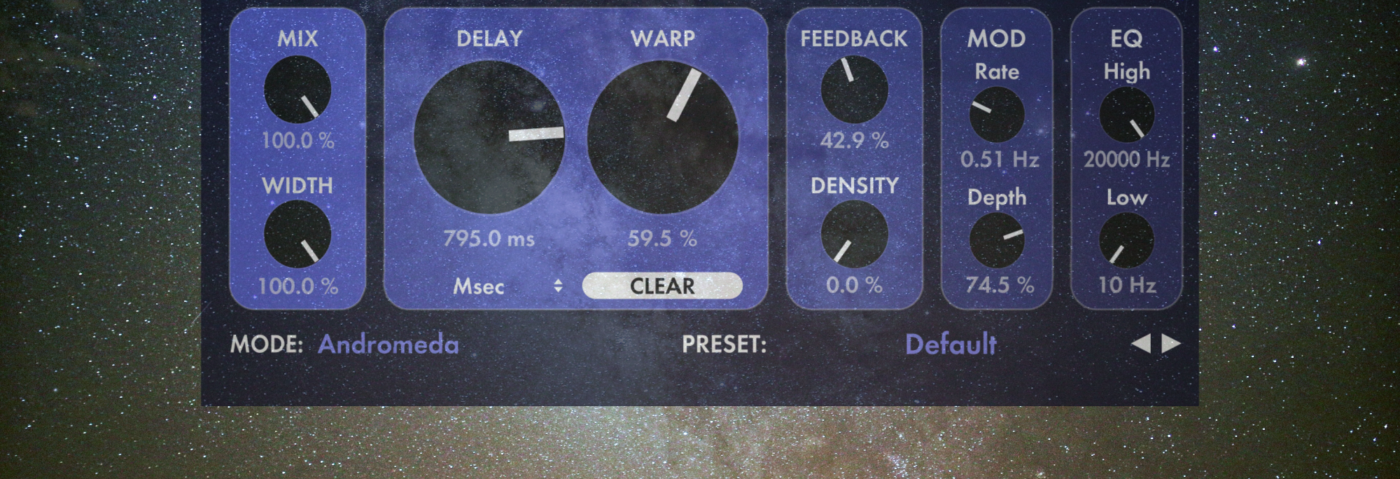
u-he are makers of award-winning software synthesisers and effects including Diva, Repro-1, Zebra2, Hive, Bazille, Presswerk and Satin.
Visit U-he

u-he are makers of award-winning software synthesisers and effects including Diva, Repro-1, Zebra2, Hive, Bazille, Presswerk and Satin.
Visit U-heIn this Synth Secrets, we create an ambient pad full of modulation and character using Valhalla DSP’s free Supermassive reverb and delay plug-in.
The next time you need a pad sound, instead of reaching for a poly plugin and trawling through the presets, why not craft your own? It’s easy to do and also ensures that no one will have the same sound.
The idea behind this patch is running a modulating arpeggiated lead synth through a slow delay set to 100% wet to generate a pad. All of the individual arpeggiated notes feeding into a slow delay makes them sound like a sustained chord or drone with changing textures, as opposed to individual notes.
Here is the sound we are going for:
Head to Valhalla DSP to download the plug-in before getting started!
Create a new MIDI track and load up your favourite synth with a mono lead-style patch. A sound that uses an oscillator with more harmonics like a saw or square wave is a good start.
The quality of the lead itself is not very important for the final sound, but a filter with a powerful resonance is key for generating a pad full of character.
We loaded up the Mini Lead 01 preset from the Mini category in Native Instruments’ Retro Machines Mk2 Kontakt library. The oscillator in the Mini category is a modest one-knob that scrolls through mono samples from the classic Minimoog synth.
Retro Machines has four filter types—we selected Daft LP. This is a lowpass filter with a resonance that can either add a lot of bass or razor-sharp, laserbeam-style movement in the high frequencies.
If you’re using Ableton Live, insert the Arpeggiator MIDI device and set the rate to 1/8. Most other DAWs will have a similar plugin—check your manual if you’re not sure. Program in a sustained chord so it has something to work with. We used an A major 7 (13) chord.
Thirdly, insert EQ Eight to cut the sub frequencies.
Here’s how this sounds:
Exaggerated filter automation will play a big part in the final sound so here is a short example of this pattern with the filter cutoff in Retro Machines modulated with the resonance set to a high 76%. The sounds here can get very sharp so don’t listen at too high of a volume!
Nothing too exciting so far, but the delay is next. Insert Valhalla Supermassive along with an EQ Eight afterwards to prevent any rumble resulting from the effects.
Set the Mix and Width knobs to the very left to 100% and select the Andromeda mode. In this mode, the delay becomes a reverb and echo with very slow attack times capable of turning even the sharpest percussive sound into a long drone.
Set the Delay to 750ms, the Warp to 60%, the feedback to around 40% and the Mod Rate to 75%. The warp parameter gradually increases the delay lengths depending on the speed and depth set in the Mod section.
The interaction of the arpeggiated notes and filter resonance with the modulating slow delay provides endless sound design possibilities.
Here’s how the same arp pattern from the previous step sounds run through Valhalla Supermassive, with Retro Machines filter cutoff set to around 2k with no modulation and a low resonance.
The final step is automating the lead arp while the delay is active. The sky is the limit here because any parameter you modulate in the synth or in the arpeggiator will result in countless different textures. You can also insert other effects before the delay to add more options!
We chose to modulate only three parameters:
We also increased the starting rate of the arpeggiator to 1/16 and set the Steps parameter to 2 so that the notes travel across three octaves.
Here’s how the modulation sounds with Supermassive deactivated:
In this state, it is a little hard to listen to because some of the filter modulation gets very loud due to the strong resonance. The screechy characteristic will sound much better as slow echoes!
There are three sections of automation here. In the beginning, the cutoff is opening slowly, in the middle the resonance is increased and there is fast cutoff frequency modulation and at the end, the arpeggiator rate is increased to 1/128 for variety.
The delay will respond to all of these changes in different ways. For example, in the middle section the fast filter modulation will result in laser-like sounds in the distance and at the end, when the arps get faster, there will be some distorted white noise.
Here is the final result with the modulated arps run through Supermassive:
Author Aykan Esen
29th October, 2020

u-he are makers of award-winning software synthesisers and effects including Diva, Repro-1, Zebra2, Hive, Bazille, Presswerk and Satin.
Download the demos and try them for yourself at www.u-he.com